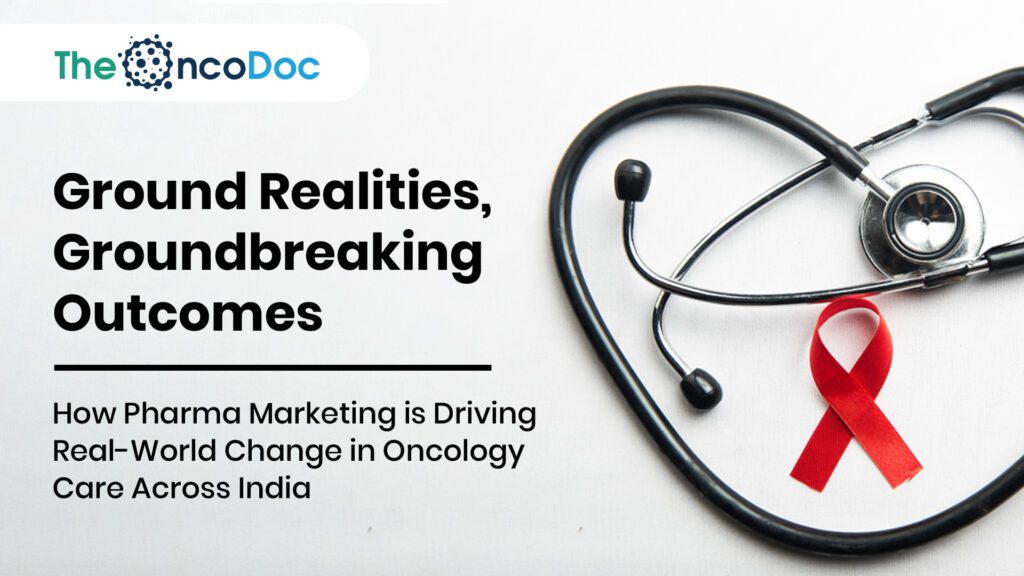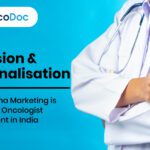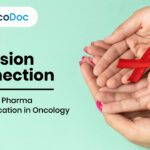Introduction: Marketing Beyond Molecules
In India, where over 70% of cancer diagnoses occur in late stages, the role of pharma marketing extends far beyond traditional promotion. It’s about influencing patient journeys, elevating HCP education, driving real-world evidence (RWE) into practice, and mobilising communities towards early screening and treatment adherence. In this new era, pharma marketers are no longer just brand custodians; they are outcome enablers.
This article explores how non-AI-driven, evidence-backed, localised, and human-centric marketing strategies are helping bridge the cancer care gap across urban and rural India, particularly in oncology.
1. Real-World Evidence (RWE): The Untapped Goldmine
Pharma marketers are increasingly leveraging real-world data from registries, EMRs, insurance records, and patient support programs to craft regionally relevant campaigns.
This data informs where screening is delayed, where treatment drop-offs are common, and where oncology awareness is absent, guiding outreach accordingly.
2. Creating the “Why” for Early Screening
For many Indians, especially in tier 2/3 cities and rural areas, screening is a luxury, not a priority. Pharma marketing needs to first build emotional urgency, not just scientific validity.
Strategies That Work:
- Campaigns highlighting survival differences between early vs late detection.
- Videos of survivors who benefited from early tests.
- Community-based mobile awareness vans in vernacular languages.
📌 Key Learning:
Information doesn’t inspire action. Empathy + storytelling does. And pharma marketing must lead the storytelling.
3. Role of Oncologists in Shaping Local Belief Systems
In many towns and semi-urban belts, the oncologist is more than a specialist; they are a myth-buster, educator, and community leader.
Pharma companies are supporting this influence by:
- Sponsoring vernacular-language Q&A sessions with oncologists on FM radio and YouTube.
- Distributing “Cancer Myths vs Facts” brochures curated by regional KOLs.
- Running “Day with the Doctor” programs in cancer hotspots.
These tactics help oncologists not just treat, but teach.
4. Why One Disease = Many Campaigns
Pharma marketers often fall into the trap of creating one-size-fits-all campaigns. But even within breast cancer, messaging must change across geographies and cultures.
For instance:
- In urban Maharashtra, the focus is on screening technology and insurance.
- In rural Bihar, the focus must shift to awareness and family-centric decision-making.
This shows that pharma marketers must research, segment, and customise messaging for real-world impact, not brand recall alone.
5. The Power of On-Ground Education in Tier 2/3 Towns
While metros respond to digital, on-ground marketing remains vital in India’s heartland. Pharma brands are adapting with:
- Oncology kiosks at weekly bazaars.
- Cancer awareness camps in partnership with ASHA workers.
- School-led mother engagement sessions on HPV and cervical health.
📌 Impact:
A single camp in Amravati led to 1,200+ screening sign-ups in 4 days, thanks to ASHA endorsement and community trust.
6. Oncology Reps 2.0 – Training the Trainers
Pharma reps focused on oncology are no longer just sales conduits they’re educators, event enablers, and digital integrators.
Top Upgrades in Rep Training:
- Cancer-specific objection handling (cultural, clinical, financial).
- Enabling CME sessions through partnerships with oncology societies.
- Training on digital detailing apps for hybrid HCP engagement.
Modern reps are now key drivers of medical education, not just promotion.
7. Partnering with NGOs for Trust-Based Campaigns
Pharma brands are increasingly co-creating cancer awareness efforts with trusted NGOs, ensuring campaigns are received with credibility and compassion.
Notable collaborations include:
- Pink Chain Campaign with local women’s groups.
- Cervical screening camps with CSR-backed NGOs.
- Oncology counselling with language-aligned community workers.
📌 Insight:
NGO-led efforts improve trust and participation by 2-3X versus brand-led standalone campaigns.
8. Driving Screening Adoption with Influencers & Survivors
Pharma marketing today involves selecting the right messenger, often not a doctor, but a survivor, caregiver, or micro-influencer.
Effective tactics:
- Instagram Reels with regional survivors.
- “My Cancer, My Fight” campaign through local teachers.
- Schoolgirl-led HPV vaccine promotions (peer-based nudges).
📌 Emotional content drives much higher conversion rates in both awareness and action.
9. Measuring What Truly Matters
Rather than just digital impressions or prescription lifts, the new oncology marketing KPIs include:
- Screening sign-ups
- CME attendance
- Time-to-diagnosis reduction
- Referral increases
- Feedback from ASHA/community workers
📌 Pharma marketers must build dashboards that track outcome metrics, not just reach or ROI.
10. Overcoming Stigma Through Brand Ambassadors
For cancers like cervical, oral, or prostate, stigma remains a roadblock. Pharma brands have effectively employed:
- Regional celebrities for radio spots (“Get screened, stay strong”)
- Survivor podcasts busting myths (“I thought it was just a cough”)
- Doctors turned influencers doing myth-busting reels in Tamil, Bengali, and Marathi.
📌 Changing perception is a long game, but marketing starts the movement.
11. Rethinking Oncology CMEs: From Passive to Practical
Pharma-supported CMEs are shifting from hotel-based slide decks to mobile-first, practical content.
Innovations include:
- WhatsApp voice-note CMEs (used widely in Rajasthan and MP).
- “Case-of-the-Week” learning groups with GPs in cancer-prone districts.
- QR-coded posters in clinics linking to short explainer videos.
📌 These efforts enhance real-world impact, especially where oncologists are few but GPs are many.
12. Going Beyond Campaigns: Building Oncology Ecosystems
The most effective pharma marketers don’t run campaigns, they build ecosystems. This includes:
- Doctor onboarding tools.
- Patient education videos.
- Screening locator websites.
- Helpline partnerships.
- Counselling bots (IVR + WhatsApp hybrid).
📌 An ecosystem approach builds trust, habit, and consistency, unlike short-term awareness bursts.
13. Role of Patient Support Programs in Long-Term Engagement
Pharma marketers in oncology are beginning to realise that marketing doesn’t end at prescription. The true impact lies in retention, adherence, and survivorship support.
Key Initiatives Include:
- Post-treatment mental health sessions with counsellors and survivors.
- Free nutrition and rehabilitation consultations.
- Monthly WhatsApp nudges on lifestyle, medication reminders, and new treatments.
📌 Impact:
Programs that offer post-diagnosis touchpoints have seen up to 40% higher therapy adherence and better brand trust.
14. Leveraging Regional Cancer Registries for Smarter Campaigns
Instead of relying only on national cancer statistics, savvy pharma marketers now access district and state-level registries to create hyperlocal campaigns.
Applications:
- If a registry indicates high head & neck cancer in Karnataka, campaigns can target tobacco-using males 40+ with regional imagery and prevention messages.
- Data-driven decision-making ensures budget efficiency and message resonance.
📌 Example:
A pharma brand used Rajasthan’s registry to roll out a tongue ulcer awareness campaign in Udaipur and Jodhpur, increasing dental referrals by 23%.
15. Cross-Industry Collaborations: Telecom, Retail & More
Some pharma brands are partnering with telecom companies, supermarkets, and employers to embed cancer screening nudges into daily life.
Innovative Collaborations:
- Vodafone sends cervical screening reminders to women over 35.
- Chemists offer QR codes linking to breast cancer self-check tutorials.
- Large employers run annual cancer awareness weeks with pharma sponsorship.
📌 Why It Matters:
Embedding oncology education into familiar systems increases reach without triggering fear or stigma, especially among working-age populations.
16. Importance of Cancer Caregiver Outreach
Often forgotten, caregivers are pivotal in treatment decision-making and continuity. Pharma marketing is starting to include caregiver-focused content:
- Short films about “a husband’s journey” or “a daughter’s hope”
- Facebook groups for oncology caregivers with pharmacist-led Q&As
- Discounted travel/stay support through co-branded health programs
📌 Insight:
Emotional support + practical tools for caregivers ensures better adherence and improved patient morale, enhancing treatment efficacy.
17. Community Pharmacy as a Marketing Touchpoint
India has over 800,000 chemists, yet they remain underused in oncology awareness. Pharma marketers are piloting:
- POS displays with self-exam instructions
- Interactive tablets for patients to assess symptoms
- Training sessions for pharmacists to refer potential cases to doctors
📌 Success Story:
In Tamil Nadu, a chain of pharmacies trained by an oncology brand reported over 600+ early referrals in just 3 months.
These five additions enrich the scope of the article by:
- Deepening focus on continuity of care (Points 13 & 16)
- Expanding marketing venues to pharmacies and telcos (Points 15 & 17)
- Reinforcing data-driven precision via regional registries (Point 14)
Conclusion: Human-Centred, Regionally-Relevant, RWE-Led
Pharma marketing in oncology is no longer about the molecule. It’s about meeting people where they are in terms of language, beliefs, access, and understanding.
To truly improve early cancer outcomes in India, pharma brands must:
✅ Build with behavioural insight, not brand legacy
✅ Co-create with GPs, ASHAs, and NGOs
✅ Train reps to be educators, not pitchmen
✅ Use real-world evidence to target, tweak, and test campaigns
✅ Empower survivors and micro-influencers to drive belief
Because in oncology, a campaign that gets someone screened early is far more powerful than one that merely raises awareness.
The Oncodoc team is a group of passionate healthcare and marketing professionals dedicated to delivering accurate, engaging, and impactful content. With expertise across medical research, digital strategy, and clinical communication, the team focuses on empowering healthcare professionals and patients alike. Through evidence-based insights and innovative storytelling, Hidoc aims to bridge the gap between medicine and digital engagement, promoting wellness and informed decision-making.



